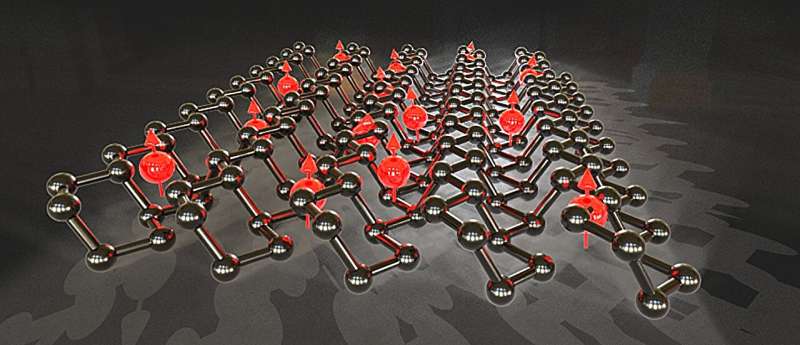This article has been reviewed according to Science X's editorial process and policies. Editors have highlighted the following attributes while ensuring the content's credibility:
fact-checked
peer-reviewed publication
trusted source
proofread
Black phosphorus propels spintronics with exceptional anisotropic spin transport

With modern electronic devices approaching the limits of Moore's law and the ongoing challenge of power dissipation in integrated circuit design, there is a need to explore alternative technologies beyond traditional electronics. Spintronics represents one such approach that could solve these issues and offer the potential for realizing lower-power devices.
A collaboration between research groups led by Professor Barbaros Özyilmaz and Assistant Professor Ahmet Avsar, both affiliated with the Department of Physics and the Department of Materials Science and Engineering at the National University of Singapore (NUS), has achieved a significant breakthrough by discovering the highly anisotropic spin transport nature of two-dimensional black phosphorus.
The findings have been published in Nature Materials.
In contrast to the conventional movement of charge in electronic devices, spintronics focuses on pioneering devices that manipulate the intrinsic property of electrons known as "spin." Similar to charges in electrons, spin gives electrons a rotational quality like they are rotating around an axis, making them behave like tiny magnets, which have both a magnitude and a direction.
The electron spin can exist in one of two states, referred to as spin "up" or spin "down." This is analogous to clockwise or anticlockwise rotation.
While traditional electronic devices work by moving charges around the circuit, spintronics operates by manipulating the electron spin. This is important because moving electrical charges around traditional electric circuits necessarily causes some power to be lost as heat, whereas the motion of spin does not intrinsically dissipate as much heat. This characteristic could potentially allow for lower-power device operation.
Researchers are particularly interested in using materials at the atomically thin limit to investigate the properties of spin "channels," which are like wires that can facilitate the transport of spins.
Emphasizing the importance of material choice in spintronics devices, Prof Özyilmaz said, "Choosing the right material is paramount in spintronics. Highly performant and functional spin channel materials are the backbone of spintronics devices, allowing us to manipulate and control spins for diverse applications."
Black phosphorus is one such emerging material which is receiving attention for its favorable spintronics properties. Black phosphorus has a unique puckered crystal structure and this means that the behavior of its spins is also dependent on their direction.
Prof Avsar said, "Black phosphorus showcases highly anisotropic spin transport, deviating from the normal isotropic behavior seen in conventional spin channel materials. Its crystal structure imparts directional characteristics to spin transport, offering new possibilities for controlling spintronics devices."
The researchers fabricated ultrathin black-phosphorus-based spin valves, encapsulated between hexagonal boron nitride layers. The spin transport anisotropy was studied by injecting spins into the black phosphorus at one end of the device, and measuring the spin signal at the other end by altering the direction of the spin current.
Measurements were conducted while applying a strong magnetic field perpendicular to the black phosphorus layer and comparing it to those when a weak magnetic field is applied.
The researchers observed that the application of a strong magnetic field resulted in a large increase in the spin signal. This effect arises from the puckered crystal structure, as the strong magnetic field forces the spins to point out of the plane of the material, altering their interaction with their surroundings and increasing their lifetime by a factor of six.
This study also uncovers that ultrathin black phosphorus exhibits electrically tunable nanosecond spin lifetimes using a back-gate. The exceptional spin anisotropy, coupled with the ability to electrically modulate spin transport, enables creating novel devices that are not solely controlled by the binary state of spin (up or down) but also leverage spin anisotropy to achieve directional control.
This positions black phosphorus as a unique platform for superior manipulation of spins—a pivotal advancement in the realm of spintronics.
More information: Luke Cording et al, Highly anisotropic spin transport in ultrathin black phosphorus, Nature Materials (2024). DOI: 10.1038/s41563-023-01779-8
Journal information: Nature Materials
Provided by National University of Singapore



















